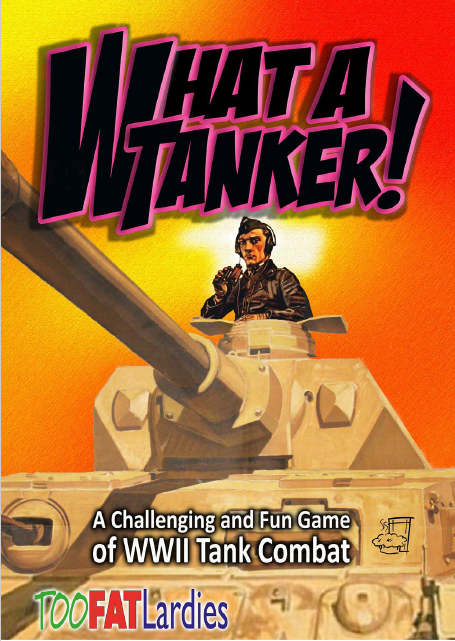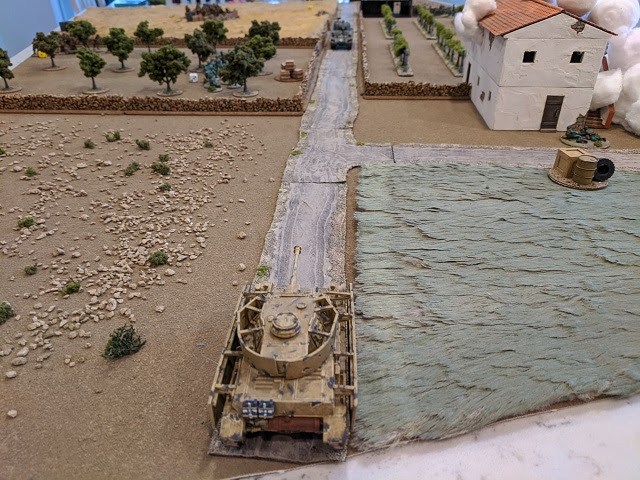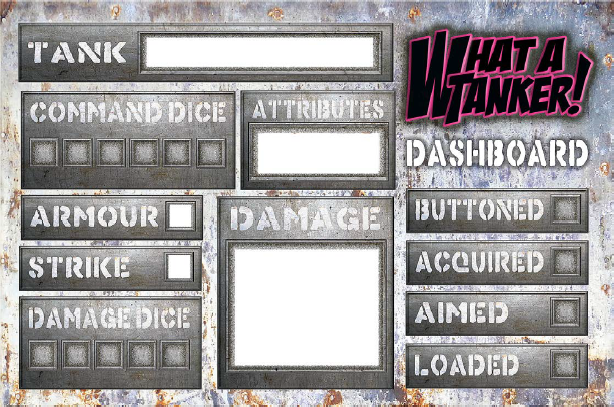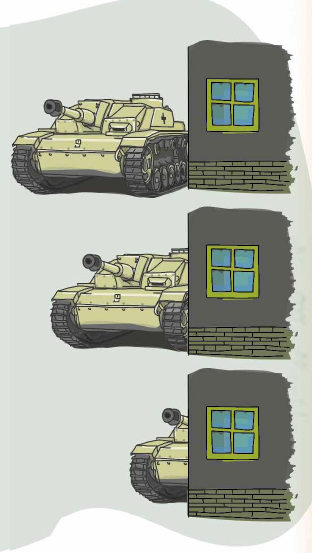Goonhammer Historicals is our series looking at the incredibly diverse world of historical wargaming – different scales, different eras, different rulesets. In honor of our current Eastern Front focus – where some of the largest tank battles of the Second World War took place – the Goonhammer Historicals team is reviewing Too Fat Lardies’ “What a Tanker” ruleset.

As I’m sure you’ve sussed out by now, there are a number of vocal proponents of the Too Fat Lardies on the Goonhammer Historicals team, and today we’re going to be talking about another of their rulesets. Released by TFL in 2018, “What a Tanker” is a fast-playing game of World War 2 armored combat. Each player takes control of one or more tanks, duking it out in fast and furious combat. With each individual tank being controlled separately, this game is perfect for conventions or club nights as it can accommodate several players at once.
Since we so often talk about scale in historical wargames, let’s get this out of the way up-front: What a Tanker is scale independent. If your models are 1/56 scale behemoths or teeny-tiny 6mm jobs, it’s all good. For the most part, the distances represented on nearly any table will be well within the engagement ranges of the main armaments of a typical tank. As a result, like many Lardie games the effective range of a weapon is not measured in inches or centimeters, but rather “can I see my target?” Line of sight and intervening terrain are far more important than distance, so don’t let scale be an impediment to giving this ruleset a go.
Also, the game exclusively uses ordinary 6-sided dice. Each player will want to have maybe a dozen or so on hand.
Gameplay
Like most Lardie games, What a Tanker places a heavy emphasis on the “friction” of combat – that is, all of the uncertainties, accidents, and circumstances beyond the combatants’ control that make armed conflict so unpredictable. The order in which players activate changes from turn to turn (using a simple initiative system), and the resources available to each tank will vary with each activation. Combined, these aspects deliver a level of tension that makes for really compelling tabletop gaming. Here’s how it works:
Activations
Each tank has a hand of Command Dice (usually a total of six to start, but this will change as the tank sustains damage). Rolled at the beginning of each turn, these dice collectively represent the activation resources available to command that tank and dictate how many actions each of the various crew positions – driver, loader, gunner, commander – will be able to take in any given turn. Players of TFL’s signature World War 2 infantry combat game “Chain of Command” (previously reviewed here for Goonhammer by Edwin “Lupe” Moriarty) will be intimately familiar with this concept.
For each 1 rolled on a Command Die, the player may activate the tank’s driver. Like most other Lardie games, movement is randomized starting from a basic 2D6. If you’re driving forward over open ground, this is how far you’ll move each time your driver is activated (and rolling multiple 1s on your Command Dice may mean your tank can cover a lot of ground in a single turn). The rules also account for all of the other stuff you might want to do with a tank, like spinning in place or turning both your hull and your turret at the same time. Turret rotation is performed in 60-degree increments, and if you buy the deluxe version of the rules that include markers and tokens there is a hexagonal “Universal Tanker Tool” that makes measuring this quick and easy.
The rules also accommodate turning your tank into an engine of delicious destruction, rumbling over hedges, plowing through stone walls, and crashing through buildings. These activities are not without risk, and dropping your tank into an unexpected cellar in a building is a quick way to cause your crew to bail out and abandon their vehicle! Here the rules are simple – minor obstacles require a single movement Command Die to cross, major obstacles require two – but show a surprising amount of nuance. For instance, tanks moving in woods can’t rotate on the spot and can’t rotate their turrets more than 60-degrees in any one Turn, representing the difficulties posed by pesky tree trunks in inconvenient locations.
Results of a 2 rolled on a Command Die represent the tank commander’s attention in trying to acquire a target. This is automatic if your target is in the open and unobscured, but the more intervening terrain features there are between you and your target, the harder this becomes and the more 2s you’ll need on your Command Dice. Here too there’s another meaningful choice the player must make, which is whether their tank’s commander is hanging out the top hatch and has a good view of the battlefield or is buttoned up inside the turret and surveying the scene through narrow vision blocks. Being unbuttoned is great for situational awareness, but once the shells start flying open hatches lead to an increased chance of a tank sustaining damage. Once a target is acquired (and you can only keep one acquired at a time), it remains acquired until it breaks line-of-sight. This makes movement, maneuver, and terrain key components of armored combat.

Command Dice of 3 represent aiming. You have to have at least one aim result to be able to engage a target, but having more increases your chances. Unlike acquisition, aiming is lost if either the firing tank or the target tank moves, though if both remain stationary the benefits of aiming can carry across multiple turns. This too illustrates one of the main tenets of armored combat: standing still once your enemy has ranged in on you is a terrible strategy.
If you’ve successfully acquired a target and have at least one aim dedicated to it, you can fire with a Command Die showing a 4. More on shooting in a moment, but shooting is intimately linked with having your main armament loaded – an activity that is controlled with a Command Die result of 5. Each time your tank fires, it must reload before it can fire again.
Command Dice showing 6 pips are “wild dice,” which can be used in a couple of different ways. First and foremost, they can be converted into any other result, so if your main cannon is unloaded and you desperately want to get off a shot on an enemy tank that’s still in your sights but didn’t roll any 5s, you can use a wild die to reload. Additionally, as your tank takes “temporary damage,” you’ll temporarily lose access to Command Dice; spending a wild die can recover these for subsequent turns. Finally, you can allocate any remaining unused wild dice to increasing your chances of gaining the initiative in the next turn.
This Command Dice system has an elegant simplicity, and really captures the chaos and uncertainty of armed conflict. Even in a ruleset that is essentially an “IGOUGO” system lacking any mechanism for interruption, you’ll still see plenty of missed opportunities and swings in momentum. There will be loads of times where you’ll absolutely want to blast an opponent’s tank, but your gun is unloaded and you don’t have the requisite 5 needed to load a shell (probably because your loader is faffing about trying to get the breech open). Or as WW2 British tank commander Lieutenant Ken Giles so eloquently put it: “The 75[mm] is firing. The 37[mm] is firing but is traversed round the wrong way. The Browning is jammed. I’m saying ‘Driver, advance!’ on the A set and the driver, who can’t hear me, is reversing. And as I look over the top of the turret and see twelve enemy tanks fifty yards away, someone hands me a cheese sandwich.”

Shooting
Once you have successfully acquired and aimed at a target – and provided you have a 4 on one of your Command Dice – you can go about the process of actually shooting at an enemy tank. Firing uses a very simple 2D6 roll, generally needing a 6 to hit. This number is influenced by intervening terrain or obscuration, as well as any additional aiming you may have performed. If you manage to score a hit, you roll a number of “strike” dice (representing the armor penetration capabilities of your main armament) and your opponent rolls a number of “armor” dice (representing the overall protection represented by the thickness, slope, and material composition of the tank’s armor). For armor, results of 5 and 6 are always saves, but for firepower dice the target number to penetrate changes depending on whether you are engaging the enemy tank from the front, flank, or rear (with the latter generally being easier to penetrate). So long as the targeted tank ends up with more saves than the firing tank has successful penetration results, the round is harmlessly deflected by the armor. But if the dice representing successful penetrations equal or exceed the successful armor saves, things start to go badly. And if you can manage to score three or more net penetrating successes than armor saves, the target tank is knocked out! For cases with one or two net penetration successes the actual results on the firepower dice matter, as these dictate whether your hit will do temporary or permanent damage. For example, when engaging an enemy head-on, rolls of 5 and 6 penetrate, but if you roll more 6s than 5s you are inflicting permanent damage.
In general, temporary damage results in a loss of Command Dice available for subsequent rounds. It reflects the fact that after a number of heavy-caliber rounds have smacked into the tank, they’re too busy soiling themselves to effectively operate the vehicle in battle. These temporarily lost dice can be recovered using Wild Dice in later turns, but any time your available Command Dice drop to zero, the crew bails out and abandons their tank.

Permanent damage has a more lasting effect. In addition to the permanent loss of Command Dice, you can suffer damage to your tank’s systems. For ease of play, tanks have just two hit locations – the hull and the turret. Permanent damage to the hull affects movement (damage to the engine, road wheels, tracks, etc), and damage to the turret affects firing (damage to optics, turret traverse mechanisms, or injury to the crew).
These relatively simple mechanics play very quickly. Rivet-counters will be disappointed at the lack of detail and the comparatively coarse grades of “armor” or “strike” capabilities, but on the whole the TFL team has done a god job of capturing the relative power of the vehicles used in throughout the conflict. Armor values range from 2 (for the light tanks of the early war) to 12 (the massive “King Tiger” and Churchill Mk VII), with most tanks being in the 4-6 range. Similarly strike values range from 3 (say, a 20mm autocannon) to 12 (the massive 88mm long-barreled cannon). While lacking in fine granularity, this system does allow for a wide variety of outcomes, from spectacular explosions to a steady, slow degradation of combat capability culminating in a defeated crew bailing out, bloodied but still alive.
Campaign Play
Having your crew survive the loss of their tank is important when you take your tabletop games from one-off engagements to campaign play. What a Tanker includes a system for tank crews gaining experience, from lowly green crews to fearsome “tank aces.” As crews gain experience in combat, they become more proficient in their craft. This is represented by a tank crew drawing a number of cards equal to its experience level (rated from 0 to 5) from a deck of special abilities. These are one-use bonus abilities that can be used to alter the odds in the crew’s favor.

And over the course of a campaign there is a “promotion tree” that allows a crew to upgrade to a newer, more capable tank – though doing so adversely affects the crew’s experience rating, as it takes some time for the crewmen to familiarize themselves with the new vehicle. So your Soviet tank crew may start the war in Finland driving a T26 and end up rolling into Berlin manning a fearsome IS-2. Like anything else in a TFL game, there are interesting and meaningful decisions to be made that will have lasting ramifications in subsequent games.
Different Tank Types
The rulebook includes pretty much all of the different variations of tank type for all of the major combatant nations of WW2. Tanks for the British, Germans, Italians, French, Americans, Soviets, and Japanese are all represented. Each also has an associated “points value” to help make scenario balance easier, though again there may not be enough granularity here to please the hard-core historians out there.
Additionally, the game makes distinctions between various types of tanks beyond simply their strike and armor values. “Fast” tanks (like the Pz II or Crusader) may always turn a single Command Die of any value to a 1, which means they are always able to move. Similarly, tank-destroyers (like the StuG III or M-18 Hellcat) can always convert a single Command Die of any value to a 3. Tanks equipped with rapid-fire weapons like the 20mm autocannon may expend multiple “Fire” Command Dice in a single turn without needing to reload between each shot. These advantages are subtle, but they really do play out in interesting ways on the tabletop, and different tanks feel very different in play.
Because the tabletop actions in What a Tanker take place at the point of the conflict itself, there is no provision made for unreliable or poorly-designed tanks. As thematic as it might be for a Crusader II to grind to a halt due to its temperamental gearbox or a hulking Tiger to be out of a fight because a repair crew needed 12 hours to change a single damaged internal road wheel, these aspects of the machines are not represented in the rules. While on the one hand this is a little disappointing, on the other no one wants to show up for game night only to be told they can’t play because their tank ran out of gas.
Extras
What a Tanker is at its core designed for tank-on-tank combat. It doesn’t include any provision for the activities of infantry in the basic ruleset. That said, if you want to add anti-tank guns or man-portable anti-tank weapon teams (Bazooka, PIAT, Panzerfaust, etc), the 2019 issue of the Lard Annual magazine (available here) has an article on integrating these into your tank games.
Also, it should be noted that for the most part the main What A Tanker ruleset deals with the mechanics of how to actually play the game, and therefore doesn’t really address “scenario” play. It’s more focused on head-to-head “versus” play rather than being a dedicated recreation of a particular historical action. That said, both the 2018 and 2019 Lard Annual magazines included scenarios specifically intended for What A Tanker, and these are worth a look. The 2018 offering (“Barkmann Corner Overdrive”) is a take on the classic “entire platoon of Shermans facing off against a single Tiger II” that occurred only a handful of times in the actual war but have been popularized by films like “Fury.”
As yet we haven’t seen any releases of the kind of “pint-sized campaign” for What A Tanker that are found supporting more familiar games like Chain of Command. Though there are occasional rumblings and rumors of these sorts of things being developed within the community, players who want this more involved kind of campaign of linked scenarios might be on their own for the time being. But if you wanted some suggestions for a place to start creating your own, I’d look at Kursk (on the Eastern Front) and Operation Crusader (in North Africa), both of which involved significant tank-on-tank battles.
Conclusion
I think What a Tanker is a huge hit. The rules a simple, elegant, and concisely written. The rulebook itself has numerous illustrations and examples, and throughout uses a charmingly cartoonish art style that makes it abundantly clear that the authors are not taking themselves overly seriously. Those historical gamers who are enthralled by the minutiae will likely be disappointed in the lack of granularity in armor slope or thickness, but the abstractions taken by the rules make the game quick to play and – most importantly – fun!
Additionally, the easy mechanics make teaching the game a snap, which in turn makes it accessible to new players. I’ve seen kids as young as 7 happily racing tanks around the convention table and blasting away like pros, and while the rules themselves are incredibly easy to pick up they encapsulate a surprising amount of nuance for those who care to look for it.
If you like tanks (and who doesn’t?) and your interest has been piqued, you can get a copy of the What A Tanker ruleset directly from the Too Fat Lardies’ website . Products range from a PDF-only version of the rules for just 16 GBP, to the deluxe bundle including the physical rulebook and and all the dashboard tokens for 27.50 GBP. And because it’s scale-independent, you can use whatever tank miniatures you like or have lying around (I first played it with my 9yo son with the tanks that came with his brown and green plastic army men). Good luck, and good tanking!


